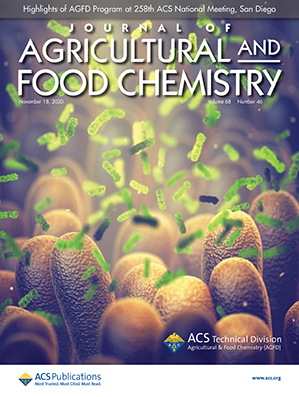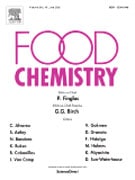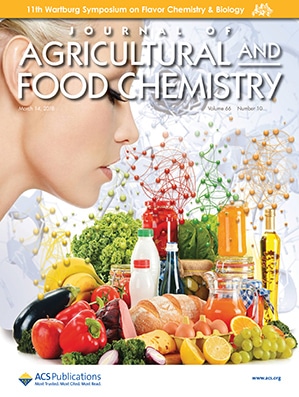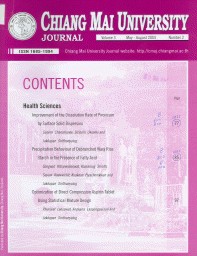
Changing the Landscape: An Introduction to the Agricultural and Food Chemistry Technical Program at the 258th American Chemical Society National Meeting in San Diego(2020)
Title : Changing the Landscape: An Introduction to the Agricultural and Food Chemistry Technical Program at the 258th American Chemical Society National Meeting in San Diego
Researcher : Michael Appell, Atanu Biswas, SeChin Chang, Wei Chen, H. N. Cheng, Jim Daily III, Xuetong Fan, Michael Granvogl, Mingming Guo, Yoshihiro Ito, Tony Jin, Masuko Kobori, Jane V. Leland, LinShu Liu, Yangchao Luo, Shaun MacMahon, Kanjana Mahattanatawee*, Sunghyun Nam, Coralia Osorio, Bosoon Park, Daxi Ren, Shengmin Sang, Fereidoon Shahidi, Michael Tunick, Chibuike C. Udenigwe, Qin Wang, Wallace H. Yokoyama, Liangli Lucy Yu, Yaqiong Zhang, and Yingdong Zhu
Department : *Food Technology Department, Faculty of Science, Siam University
E-mail : *kanjana@siam.edu
ฐานข้อมูลงานวิจัย มหาวิทยาลัยสยาม : –
Link to article: Journal of Agricultural and Food Chemistry, 2020, 68(46), pp. 12769–12772. https://doi.org/10.1021/acs.jafc.0c02809
Publication: Journal of Agricultural and Food Chemistry / in Scopus
Bibliography : Appell, M., Biswas, A., Chang, S., Chen, W.,Cheng, H. N., Daily III, J., Fan, X., Granvogl, M., Guo, M., Ito, Y.,Jin, T., Kobori, M., Leland, J. V., Liu, L., Luo, Y.,MacMahon, S., Mahattanatawee, K.,Nam, S., Osorio,C., …Zhu, Y. (2020). Journal of Agricultural and Food Chemistry, 68(46), 12769–12772. https://doi.org/10.1021/acs.jafc.0c02809

Comparison of aroma active and sulfur volatiles in three fragrant rice cultivars using GC–Olfactometry and GC–PFPD (2014)
Researcher : Kanjana Mahattanatawee*, Russell L. Rouseff
Department : *Food Technology Department, Faculty of Science, Siam University
E-mail : *kanjana@siam.edu
Abstract : Aroma volatiles from three cooked fragrant rice types (Jasmine, Basmati and Jasmati) were characterised and identified using SPME GC–O, GC–PFPD and confirmed using GC–MS. A total of 26, 23, and 22 aroma active volatiles were observed in Jasmine, Basmati and Jasmati cooked rice samples. 2-Acetyl-1-pyrroline was aroma active in all three rice types, but the sulphur-based, cooked rice character impact volatile, 2-acetyl-2-thiazoline was aroma active only in Jasmine rice. Five additional sulphur volatiles were found to have aroma activity: dimethyl sulphide, 3-methyl-2-butene-1-thiol, 2-methyl-3-furanthiol, dimethyl trisulphide, and methional. Other newly-reported aroma active rice volatiles were geranyl acetate, β-damascone, β-damascenone, and ɑ-ionone, contributing nutty, sweet floral attributes to the aroma of cooked aromatic rice. The first two principal components from the principal component analysis of sulphur volatiles explained 60% of the variance. PC1 separated Basmati from the other two cultivars and PC2 completely separated Jasmine from Jasmati cultivars.
Keywords: PCA, Cooked rice, Headspace SPME
Link to Publication: Food Chemistry/ in Sopus
Bibliography : Mahattanatawee, K., & Rouseff, R. L.(2014). Comparison of aroma active and sulfur volatiles in three fragrant rice cultivars using GC–Olfactometry and GC–PFPD. Food Chemistry, 154, 1-6.

Comparison of Aroma Character Impact Volatiles of Thummong Leaves (Litsea petiolata Hook. f.), Mangdana Water Beetle (Lethocerus indicus), and a Commercial Product as Flavoring Agents in Thai Traditional Cooking (2018)
Researcher : Kanjana Mahattanatawee, Torsak Luanphaisarnnont, Russell Rouseff
Department : Food Technology Department, Faculty of Science, Siam University
E-mail : kanjana@siam.edu
Abstract : Thummong (Litsea petiolata Hook. f.) is a tree native to southern Thailand. The leaves of this tree are highly aromatic and used to flavor Thai dishes in place of the traditional water beetle Mangdana (Lethocerus indicus) for religious and cultural reasons. Total and aroma-active volatiles from both flavoring materials were compared using gas chromatography–olfactory (GC–O) and gas chromatography–mass spectrometry (GC–MS). The volatiles from Thummong leaves and the Mangdana water beetle were collected and concentrated using headspace solid-phase microextraction. A total of 23 and 25 aroma-active volatiles were identified in Thummong leaves and Mangdana, respectively. The major aroma-active volatiles in Thummong leaves consisted of 7 aldehydes, 5 ketones, and 3 esters. In contrast, the aroma-active volatiles in the water beetle consisted of 11 aldehydes, 3 esters, and 2 ketones. Both had (E)-2-nonenal as the most intense aroma-active volatile. The water beetle character impact volatile (E)-2-hexenyl acetate was absent in the leaves, but its aroma character was mimicked by 11-dodecen-2-one in the leaves, which was absent in the beetle. In addition, a commercial Mangdana flavoring was examined using GC–O and GC–MS and found to contain only a single aroma-active volatile, hexyl acetate. All three flavoring sources exhibited similar aroma characteristics but were produced from profoundly different aroma-active volatiles.
Link to Publication: Journal of Agricultural and Food Chemistry, Vol.66 Issue 10 March 2018
Bibliography : Mahattanatawee, K., Luanphaisarnnont, T., & Rouseff R. (2018). Comparison of aroma character impact volatiles of thummong leaves (litsea petiolata hook. f.), Mangdana water beetle (lethocerus indicus), and a commercial product as flavoring agents in Thai traditional cooking. Journal of Agricultural and Food Chemistry, 66(10), 2480-2484.

Improving the Flavor of Soy Ice Cream by Adding Lemongrass or Pandan Leaf Extracts (2014)
Title : Improving the Flavor of Soy Ice Cream by Adding Lemongrass or Pandan Leaf Extracts
Researcher : Sirinat Natisri, Kanjana Mahattanatawee*, Siwatt Thaiudom
Department : *Food Technology Department, Faculty of Science, Siam University
E-mail : *kanjana@siam.edu
Abstract : Lemongrass or pandan leaf extracts were used separately to improve the flavor of soy ice cream. Lemongrass or pandan leaf extracts with water in concentrations of 10: 100, 15: 100, and 20: 100 w/w were examined using sensory evaluation for the best flavor acceptance. The best ratio was selected to spray dry using maltodextrin as the drying medium at various concentrations (2, 4, 6, 8 and 10% w/w). A ranking preference test was used to determine the flavor of the soy ice cream. Threshold testing was used to determine the sensorial quality of soy isolate protein mixed with both herb extracts, and soy ice cream mixed with both herb extracts. The flavor compound was analyzed by using headspace, solid-phase microextraction, gas chromatography, mass spectrophotometry (HSSPME-GC-MS). The best concentration of fresh lemongrass or pandan leaf extracts for improving the sensorial flavor of soy ice cream was 10: 100 (w/w). The optimum quantity of maltodextrin for spray drying was 2%(w/w). The threshold values of fresh and powdered lemongrass extracts that could mask the beany flavor in soy protein isolate solution and soy ice cream were lower than those of fresh and powdered pandan leaf extracts. The beany flavor in soy protein isolate solution and soy ice cream was mainly composed of hexanal, pentanal, benzaldehyde, 2-pentyl-furan and 1-octen-3-ol. The flavor compounds in pandan leaf extract were 2-acetyl-1-pyroline and 3-methyl-2 (5H)-furanone, while those of lemongrass extract were β-myrcene, α-pinene, 3-carene, neral, geranial and geraniol. From the results of HS-SPME-GC-MS, the beany flavor was masked by these extracts. This indicated that lemongrass and pandan leaf extracts could mask the beany flavor and improve the sensorial quality of soy ice cream.
Keywords: Ice cream, Lemongrass, Pandan leaf, Beany flavor, Headspace, Solidphase microextraction, Gas-chromatography, Mass spectrophotometry
Link to Publication: CHIANG MAI UNIVERSITY JOURNAL OF NATURAL SCIENCES/Natural and Life Sciences Communications Volume 13, Issue 01(S) DECEMBER 2014
Bibliography : Natisri, S., Mahattanatawee, K., & Thaiudom, S. (2014). Improving the flavor of soy ice cream by adding lemongrass or Pandan leaf extracts. Chiang Mai University Journal of Natural Sciences, 13(1 s), 469-482.

The First Joint ACS AGFD and ACS ICSCT Symposium (2015)
Title : The First Joint ACS AGFD and ACS ICSCT Symposium
Researcher : Rimando, A.M., Mahattanatawee, K.*,
Department : *Food Technology Department, Faculty of Science, Siam University
E-mail : *kanjana@siam.edu
ฐานข้อมูลงานวิจัย มหาวิทยาลัยสยาม : –
Link to article: Journal of Agricultural and Food Chemistry, 2015, 63(43), pp. 9379–9380. https://doi.org/10.1021/jf504201z
Publication: Journal of Agricultural and Food Chemistry / in Scopus
Bibliography : Rimando, A. M. & Mahattanatawee, K. (2015). Journal of Agricultural and Food Chemistry, 63(43), 9379–9380. https://doi.org/10.1021/jf504201z